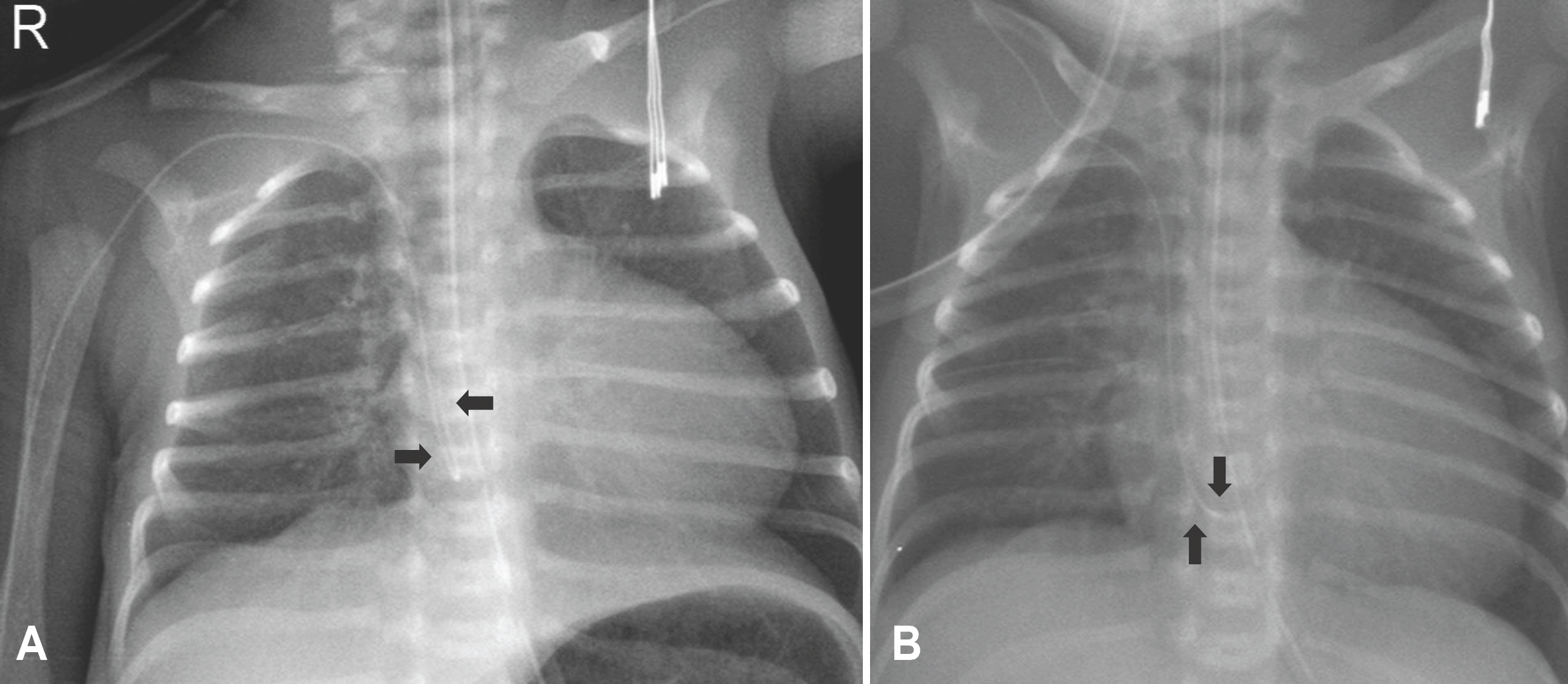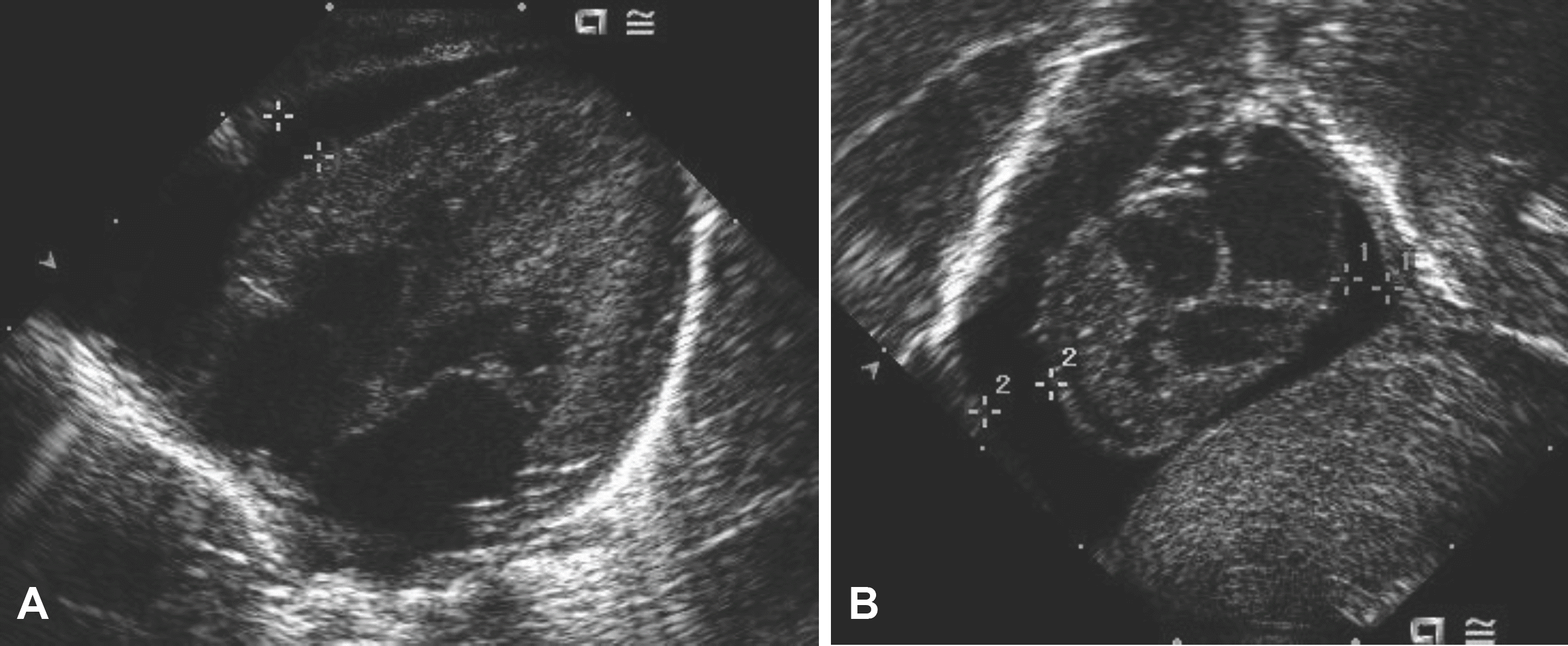Abstract
Peripherally inserted central venous catheters (PICC) are commonly used to provide long term intravascular access for parenteral nutrition and medications in preterm infants, but rarely life-threatening complications associated with malposition of catheter tip such as pericardial effusion may be developed. We report a preterm case of early-onset pericardial effusion related to PICC of which the distal part is angulated and located in the right atrium of heart.
References
1. Racadio JM, Doellman DA, Johnson ND, Bean JA, Jacobs BR. Pediatric peripherally inserted central catheters: complication rates related to catheter tip location. Pediatrics. 2001; 107:e28.

2. Ohki Y, Maruyama K, Harigaya A, Kohno M, Arakawa H. Complications of peripherally inserted central venous catheter in Japanese neonatal intensive care units. Pediatr Int. 2013; 55:185–9.

3. Nowlen TT, Rosenthal GL, Johnson GL, Tom DJ, Vargo TA. Pericardial effusion and tamponade in infants with central catheters. Pediatrics. 2002; 110:137–42.

4. Jumani K, Advani S, Reich NG, Gosey L, Milstone AM. Risk factors for peripherally inserted central venous catheter complications in children. JAMA Pediatr. 2013; 167:429–35.

5. Darling JC, Newell SJ, Mohamdee O, Uzun O, Cullinane CJ, Dear PR. Central venous catheter tip in the right atrium: a risk factor for neonatal cardiac tamponade. J Perinatol. 2001; 21:461–4.

6. Beardsall K, White DK, Pinto EM, Kelsall AW. Pericardial effusion and cardiac tamponade as complications of neonatal long lines: are they really a problem? Arch Dis Child Fetal Neonatal Ed. 2003; 88:F292–5.

7. Nadroo AM, Lin J, Green RS, Magid MS, Holzman IR. Death as a complication of peripherally inserted central catheters in neonates. J Pediatr. 2001; 138:599–601.

8. Pizzuti A, Parodi E, Abbondi P, Frigerio M. Cardiac tamponade and successful pericardiocentesis in an extremely low birth weight neonate with percutaneously inserted central venous line: a case report. Cases J. 2010; 3:15.

9. Warren M, Thompson KS, Popek EJ, Vogel H, Hicks J. Pericardial effusion and cardiac tamponade in neonates: sudden unexpected death associated with total parenteral nutrition via central venous catheterization. Ann Clin Lab Sci. 2013; 43:163–71.
10. Pezzati M, Filippi L, Chiti G, Dani C, Rossi S, Bertini G, et al. Central venous catheters and cardiac tamponade in preterm infants. Intens Care Med. 2004; 30:2253–6.

11. Giacoia GP. Cardiac tamponade and hydrothorax as complications of central venous parenteral nutrition in infants. J Parenter Enteral Nutr. 1991; 15:110–3.

12. Kim JS, Park HG, Go KH, Kim ER. A case of pericardial effusion complicating a percutaneous central venous catheterization in premature infant. J Korean Soc Neonatol. 1996; 3:100–4.
Fig. 1.
Chest X-ray showing the PICC tip positions. (A) Partly looped catheter tip (arrows) located in the right atrium, and (B) distal part of catheter (arrows) is still placed in the right atrium. Abbreviation: PICC, peripherally inserted central venous catheter.

Fig. 2.
Echocardiographic findings of the patient. (A) Apical four chamber view, there is an approximately 3.8 mm space between the epicardium and pericardium (asterisks), consistent with pericardial effusion at anterior portion of the right ventricle. (B) Subxyphoid view showing the fluid accumulation at posterior portion of the left atrium (asterisks 1) and anterior portion of the right ventricle (asterisks 2), 3.1 mm and 5.2 mm respectively.





 PDF
PDF ePub
ePub Citation
Citation Print
Print


 XML Download
XML Download